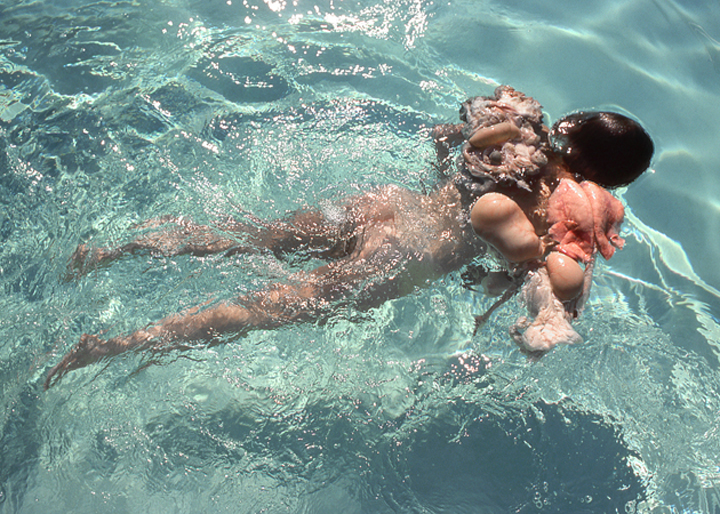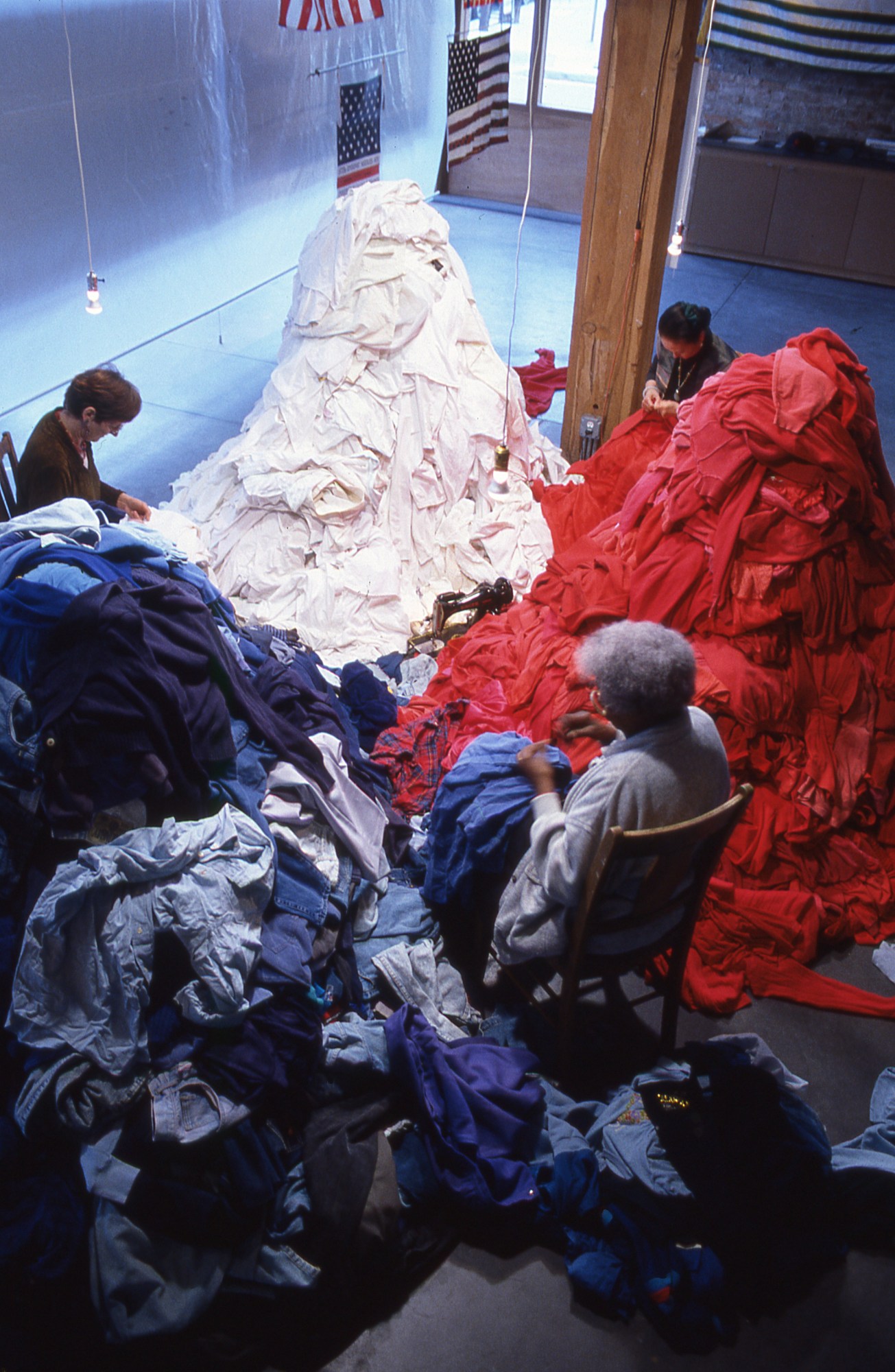This article originally appeared on i-D US.
Curators Rudolf Frieling, Lucía Sanromán, and Dominic Willsdon are the masterminds behind the new exhibit “Suzanne Lacy: We Are Here
.” It’s the first full retrospective of the feminist artist’s nearly 50 year career and it’s showing at two San Francisco-based institutions simultaneously. The three individuals have spent the last few years working to construct a cohesive story about Lacy’s work to be shown at both the SFMOMA and Yerba Buena Center for the Arts.
Bringing together different strands of Lacy’s long established practice, the trio had the unusual opportunity to utilize both spaces to spotlight the 73-year-old artist’s prolific career concurrently, but two in distinct ways. Accordingly, the SFMOMA tells a broad and rich history of her feminist art, while the YBCA showcases her community organizing projects. From art installations to writings and teachings, the Los Angeles-based creative has worked tirelessly to address social issues such as feminism, violence against women, racism and labor rights for nearly five decades.
Championing the power of collective action, Lacy’s dual exhibition shows us how institutional spaces like museums can serve as places for highlighting the current activism movement’s storied past while also imagining a new, more equal future. The curators further expressed, “Yes, her work resonates very much with our current times — given her focus on issues such as the rights of women, the role of media in criminalising youth of color, the importance of dialogue across divides of gender, age, race and class — these are of central importance everywhere today, including in museums, and we expect it will continue to resonate for the foreseeable future.”

i-D spoke with the artist about why community engagement is essential to her creative practice, how she produces large-scale projects, and why everyone should be an activist.
How did you become interested in art that’s focused on social engagement?
I grew up in the central valley of California, which was a working class farming community. I was interested in social issues as a child. At first, it was homeless and hungry cats, but after five I began to understand, in some primitive way, injustice. There was not a lot of understanding about gender prejudices, but I surmised through movies and reading about the Salem witch trials that women might not be treated equally to men. The interest naturally extended to other kinds of people, and was crystalized as I read magazines, like LIFE, that showed both Jews treatment in the Holocaust and lynchings of black Americans.
I was going to be a medical doctor, specializing in psychiatry. I got my first degree in zoology and then went to grad school for psychology. At that time, social identity issues were on the rise, most specifically the Civil Rights Movement. A bit later, in California, we were concerned with how working class boys were sent to Vietnam and how farmworkers in the Central Valley were being mistreated. While I was in grad school I met Judy Chicago, who was establishing an art program for young women, and was a pronounced feminist. So, I became part of her program, which led me in the direction of art.
What was it like being at the forefront of a new artistic movement in the 70s, particularly being a woman in a time when female artists weren’t really supported?
They weren’t supported at all. People don’t always recognize what it was like then, particularly given that there are so many women in the art world now. While there’s still a lot of discrimination (men’s art prices are higher, they are better recognized, etc.), at that time there were very few women at all recognized or exhibited. There were a lot of women who were beginning to write about discrimination in fields from medicine to art and beyond.
But it’s very hard for today’s young women to realize what it was like with almost no women in positions of power. In the early 70s, if you talked about being afraid of being raped, people would actually presume that that meant you wanted to be raped. There wasn’t an awareness of the extent of women’s trauma globally, and in the US we were just beginning to surface issues. In 1970, when I began working on violence against women, it was still legal to rape your wife in the state of California. There was a blanket of secrecy around women’s experiences that, over the course of my lifetime, has become more exposed.
Did you ever receive any backlash for what you were trying to accomplish?
Yeah, we did. I remember once being onstage with artists Judy Chicago and Faith Wilding. Faith said something that was so provocative to one of the men in the audience that he jumped up on stage and tried to strangle her.

So why is collaboration and community activation important to your practice?
Collaboration is prominent in theatrical practices, and although I come from fine art performance, which is more of an individualistic process, nevertheless I like working with others who know more than I in different areas. Also, I think that the subtleties of human interaction are fascinating and ordinary people’s communications can be very moving.
Not all my work is political, but if you are interested in politics and the long haul of social change, then forming coalitions and partnerships is important. I don’t know if I’ll see a woman elected president my lifetime, and that’s a long time waiting. But in that long haul of social justice work, it’s very critical that you value those people who have come before you and on whose shoulders you stand. Collaboration is a way to mobilize people who have shared values. It places you in a long trajectory, of those who came before you and those younger folks who will continue this movement towards social justice.
What is your process for creating big community projects?
Usually I’m invited someplace. Sometimes the institution has an idea of an issue, but sometimes not. As part of my work process I do an informal survey of different topics to where my interests and knowledge intersect with others. Essentially, I try to understand a place and look for issues, talk to a lot of people and then assess the social and political structures that are relevant to that issue. Next, I try to figure out how that issue is being addressed now, in the “public eye” (recognizing there are many different publics), and how it impacts people. I work with participating institutions and people to develop a shared agenda. People bring their personal values into the mix and I think that is what makes work emotionally and politically powerful.
What do you hope people will take away from seeing these exhibits?
On an artistic level I think it will validate the ways in which social practice, as we now call it, is long-lived, community-based, and an important trajectory in art. For this world, the exhibition is yet another experiment in how you tell the story of artists working outside the mainstream, collaborating with large groups of people, and bringing social issues to the fore. And for the general population that will see the show, and for youth, I think it will appeal because the work explores important issues such as racism, ageism, class, and violence.
Should more art be activist-driven?
I tend to see activism as a human endeavor that goes along with citizenship. You can be an activist as a doctor, you can be activist as a psychotherapist, and you can be activist as an artist. We need to be thinking about how artists, and others, can participate fully in equity movements as a responsibility of citizenship. I don’t think art has to be activist-driven, but I happen to be more interested in such art. For a long time to be an activist as an artist has not been really popular or well received. But it’s just a way of expressing your citizenship.
